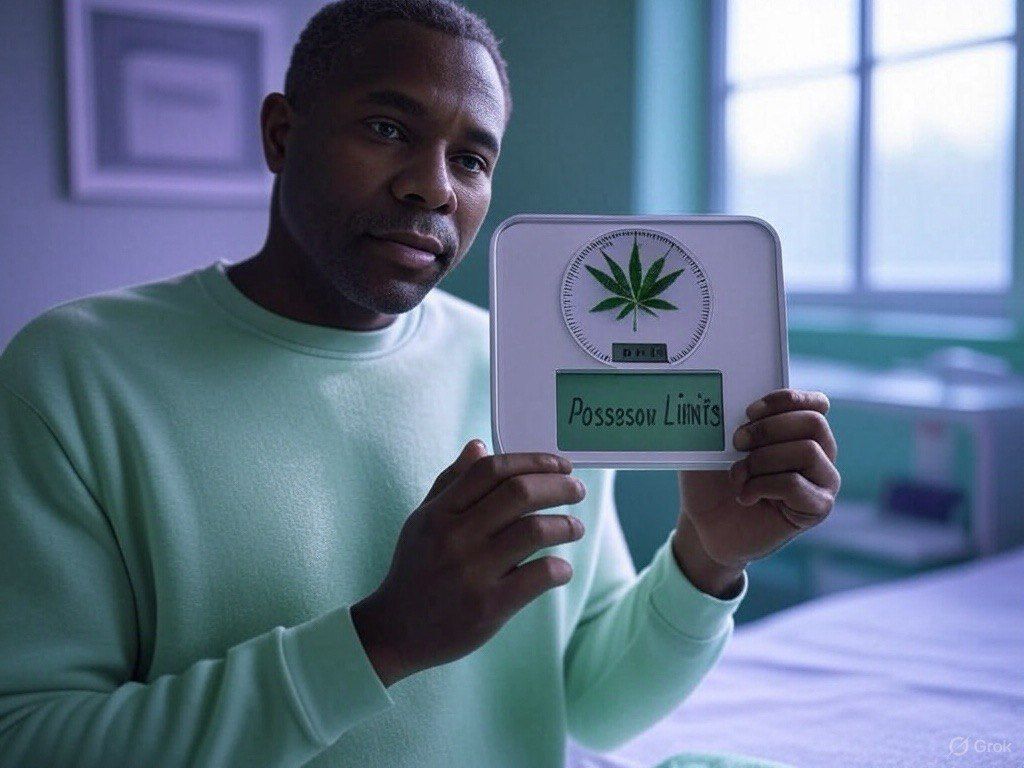Understand Possession and Usage Limits for Medical Marijuana
Staying Compliant with Legal Restrictions
Understanding possession and usage limits is essential to staying compliant with medical marijuana laws and avoiding legal issues. At Weedcoin, we’re here to clarify these rules through the MediWeed Hub with irie vibes. In this article, we’ll explore the possession and usage limits for medical marijuana, from state-specific rules to travel considerations. Whether you’re managing your treatment or planning a trip, knowing these limits keeps you safe—let’s dive into the regulations!

Possession and usage limits vary by region and are designed to ensure safe, legal use of medical marijuana.
Possession Limits in the U.S.
In the U.S., states set specific possession limits for medical marijuana patients. Some states allow patients to possess up to 120 grams of flower (about 4 ounces) or 36 grams of THC in other forms (e.g., edibles, tinctures) per 30-day period. Others permit 8 ounces of flower, while some allow 2 ounces but let doctors recommend more for severe conditions. These limits apply to what you can have on hand at any time—exceeding them can result in fines or legal action, even with a medical card. Keep your purchases within these limits, and retain receipts to prove compliance—Michael tracked his monthly purchases to stay under his state’s 2-ounce limit.
Possession Limits in Other Regions
Outside the U.S., limits vary widely. In Canada, patients can possess up to 150 grams of dried cannabis (or equivalent in other forms) per 30 days, based on their doctor’s medical document. In Germany, patients are limited to the amount prescribed—typically 20–40 grams of flower per month, dispensed through pharmacies. In Australia, possession limits are tied to prescriptions, often 10–20 grams per month, depending on the condition. Uruguay allows medical patients to possess up to 40 grams per month, with the option to grow their own (up to 6 plants). Always check your region’s specific limits on government websites or through the
MediWeed Hub to avoid penalties.
Usage Limits and Restrictions
Usage limits often dictate where and how you can consume medical marijuana. In the U.S., most states prohibit public consumption—fines can be imposed for smoking cannabis in public spaces. Consumption is typically restricted to private residences, and some states ban smoking (but allow vaping or edibles) in multi-family housing due to secondhand smoke concerns. In Canada, public consumption is banned, with exceptions for designated areas in some provinces. In Germany, medical cannabis use is restricted to private settings, and driving under the influence is strictly prohibited—detectable THC levels can result in a DUI charge. Understand your region’s usage rules to avoid fines or legal issues.
Travel Considerations and Restrictions
Traveling with medical marijuana can be risky due to varying laws. In the U.S., federal law prohibits transporting cannabis across state lines, even between legal states—patients caught at airports or federal checkpoints risk arrest. Within a state, keep your cannabis in its original packaging with a receipt, and carry your medical card—some states allow in-state travel with up to 120 grams. Internationally, most countries ban cannabis, even for medical use—Canada allows domestic travel with up to 150 grams, but crossing into the U.S. is illegal. In Europe, patients in Germany can travel within the EU with a certificate for their prescription, but amounts are limited to a 30-day supply. Always research travel laws, and consider alternatives like CBD-only products (legal in more regions) if traveling to restrictive areas.
Storage and Safety Requirements
Proper storage is part of staying compliant and safe. Most regions require cannabis to be stored in child-resistant containers, out of reach of children and pets—accidental ingestion by children can lead to serious health risks. In many places, dispensaries provide child-resistant packaging, but patients must ensure it remains secure at home. Label your products clearly to avoid confusion with recreational cannabis, especially in states with dual programs. If you’re growing your own (allowed in Canada or Uruguay), adhere to plant limits—Canada permits 6 plants per household for medical use. Safe storage also protects your supply from theft or degradation—keep it in a cool, dark place to maintain potency.
Practical Tips
- Check your state’s possession limits—e.g., 120 grams in some states—and track purchases to stay compliant.
- Consume cannabis only in private residences to avoid public use fines.
- Don’t travel across state or national borders with cannabis—federal laws in the U.S. prohibit it.
- Store cannabis in child-resistant containers, out of reach of children, to prevent accidental ingestion.
- Keep receipts and your medical card on hand to prove compliance if questioned by authorities.
Key Takeaways
- U.S. states often allow 120 grams of flower per 30 days; limits vary by region.
- Canada permits 150 grams, while Germany ties limits to prescriptions (20–40 grams/month).
- Public consumption is banned in most regions—use in private to avoid fines.
- Federal laws prohibit interstate travel with cannabis in the U.S.; international travel is risky.
- Store cannabis securely in child-resistant containers to comply with safety regulations and prevent accidents.













